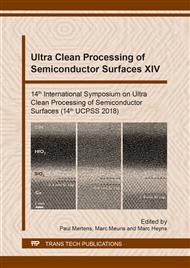p.213
p.220
p.226
p.232
p.238
p.244
p.250
p.256
p.263
Process Parameter Control for BEOL TiN Hard Mask Etch-Back
Abstract:
In this paper we demonstrate an effective process control mechanism to significantly improve on the process performance of a BEOL post-etch cleaning process with an integrated partial or complete removal of the TiN HM (hard mask) layer by so called formulated chemistries on a single wafer processing tool. The novel process control mechanism enables a 50% reduction in chemical consumption while achieving an at least equivalent TiN etch uniformity.
Info:
Periodical:
Pages:
238-243
Citation:
Online since:
August 2018
Price:
Сopyright:
© 2018 Trans Tech Publications Ltd. All Rights Reserved
Share:
Citation:


